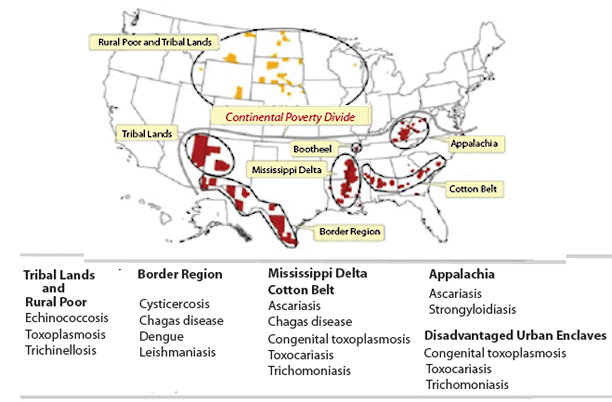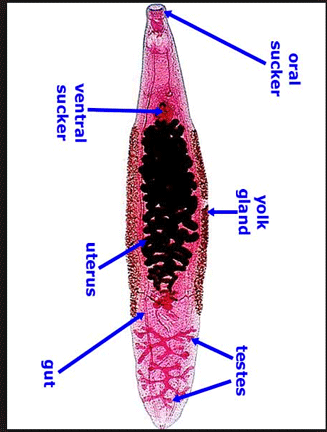
We will start our survey of major parasites of man and his pets with a group containing many of the species that initially defined the field of Parasitology. For a few decades, Parasitology was synonymous with the study of only parasitic worms or Helminth parasites. This is why I used so many worm parasites as examples in the first three lesson guides.
It is hard to imagine even prehistoric humans not noticing these large parasites that sometimes were expelled by the body. In some cases they could even connect troubling symptoms with the proper worm. What came much more slowly was the recognition of their life cycle and attempts to control their spread. At one time the surveys that this and the next two guides treat, would constitute an entire traditional course in parasitology. Today most courses also include a bit on methods used to detect and treat parasites. Few include the conceptual introduction you just completed.
Visit the website. http://www.cdc.gov/globalhealth/ntd/diseases/index.html Note that the list contains diseases that for the most part are caused by parasites. Among the helminth diseases are Cysticercosis, Dracunculiasis (Guinea Worm Disease), Echinococcosis, Fascioliasis, Onchocerciasis, Schistosomiasis and a grab bag of nematode diseases lumped together as soil-transmitted Helminths. https://www.cdc.gov/globalhealth/newsroom/topics/ntds/index.html
Below is a map based on WHO data. This map identifies a number of helminths that still continue to be problematical for the US. Examine the map and answer question one.

There are two clades or taxonomic groups, Platyhelminthes and Nematoda, that contain most of the "worm" parasites. Nematodes cause more of the problematic diseases. Most of this has to do with their tendency for auto infection, and so the potential for the parasitic burden of individuals to skyrocket. Those that are carried by vectors often attack, as in the case of canine heartworms, vital organs. Interestingly parasitic nematodes when compared to free living nemaodes, do not with the exception of mouth morphology, show much modification for their parasitic life style.
Visit this website, which examines the basic biology of nematodes http://nematode.unl.edu/what-is-a-nematode.htm Answer question two.
Soil transmitted nematodes
We will first look at the soil transmitted helminths that cause problems for humans and their pets. Using the links to common soil transmitted parasites on the following web pages, further explore the human parasites belonging to this group.
https://www.cdc.gov/parasites/sth/ Note how easily they can be transmitted.
http://www.cdc.gov/parasites/pinworm/index.html and
http://www.cdc.gov/parasites/strongyloides/index.html
Answer question three.
Soil transmitted nematodes are also a problem for our pets. And whenever a pet is involved there is always a concern that the parasite could be transfer to humans, especially children.
Use the maps on this page to determine if your dog or cat could develop a soil transmitted helminth infection. (Examine information for all hook, whip and roundworms.) Use the data for 2020.
https://capcvet.org/maps/#/2020/all-year/roundworm/dog/united-states
https://capcvet.org/maps/#/2020/all-year/hookworm/dog/united-states
https://capcvet.org/maps/#/2020/all-year/whipworm/dog/united-states
Answer question 4a.
Then focus learning the life cycles of, and public health concerns regarding, these parasites.
https://capcvet.org/guidelines/ascarid/
https://capcvet.org/guidelines/hookworms/
https://capcvet.org/guidelines/trichuris-vulpis/
Answer question 4b and 4c. Click on Public Health Considerations for specific answers to HW question.
Vector borne nematodes
Trichinellosis (or trichinoses), in the United States, and Dracunculiasis, Lymphatic filiariasis, and Onchocerciasis in tropical areas, are nematode based diseases that cause serious problems for humans. Your textbook adds another to be considered in chapter two, Anisakiasis (around pgs. 49-50 in hardbound text). . Explore these diseases on these CDC websites http://www.cdc.gov/parasites/anisakiasis/
http://www.cdc.gov/parasites/trichinellosis/
https://www.cdc.gov/parasites/lymphaticfilariasis/
https://www.cdc.gov/parasites/guineaworm/index.html
https://www.cdc.gov/parasites/onchocerciasis/index.html
and read chapter two about Trichinellosis (around pages 32-30), (Anisakiasis) around pages 49-50 and chapter nine for others (around pages196-204) in your text. Different digital and hard copies of the text will have different page numbers associated with topics. Answer question 5.
One of the worst dog diseases is caused by a nematode. Everyone who owns a dog should be familiar with heartworm. It is a horrible parasitic disease that slowly kills its host. Cures are difficult and often the worms have to be removed by a painful surgery. Often dogs do not survive surgery or survive the harsh poisons given to destroy the worms. Dying worms in the heart and associated vessels invoke a host of problems. http://www.youtube.com/watch?v=phCod-0tfkE
Explore these websites and answer question 6.
https://capcvet.org/maps/#/2020/all-year/heartworm-canine/dog/united-states
Platyhelminthes:
The two main groups causing problems for humans and pets are, Cestodes or the tapeworms, and Trematodes or flukes.
Wikipedia has an excellent discussion on Platyhelminthes. For now focus on distinguishing features (https://en.wikipedia.org/wiki/) and the two main parasitic groups, Trematoda (https://en.wikipedia.org/wiki/Trematoda) and (Cestoda https://en.wikipedia.org/wiki/Cestoda) Using this information and the diagrams below answer question 7
Diagrams
Free living flatworm
Adult trematodes or flukes look somewhat like free living flatworms with suckers.

Cestodes or tapeworms are the most modified structurally of the group.
They consists of scolex and essentially proglottids which are segments containing reproductive organs and eggs.
Even the integument is highly modified so that nutrients can be absorbed across it. The protoplasm of several cells unite forming a continuous layer below the microthriches. This arrangement also allows the tapeworm some protection from the hostile environment of the intestine, most of the cell is recessed and below protective muscle. .
Most parasitic flatworms have complex life cycles involving various intermediary hosts. Trematodes or flukes boost a variety of different larvae that can reproduce asexually, and give rise to more of that particular form, or the next stage in the life cycle.
Possible life cycle stages for flukes
Egg – discharged either in open water or in intestine of a mollusk.
Miracidium (plural Miracidia) – free-living motile form, covered with cilia, which becomes a sporocyst.
Sporocyst – an elongated sac that produces either rediae or more sporocysts.
Redia (plural rediae) – a larval form with an oral sucker, it will produce either more rediae, or cercariae.
Cercaria (plural cercariae) – another larval form of the parasite, developed within the germinal cells of the sporocyst or redia. A cercaria has a tapering head with large penetration glands. It may or may not have a long swimming "tail", depending on the species. The motile cercaria finds and settles in a host where it will become either an adult or Metacercaria.
Mesocercaria – a cercaria that is little modified but resting.
Metacercaria – a cercaria that is encysted and resting.
Adult – the fully developed mature stage, capable of sexual reproduction.
An example of a life cycle of a fluke (Fasciola hepatica in this example) showing all stages of the life cycle. The cercaria in this species encyst on grass stems and wait to be injected with the grass by a large herbivore, usually a sheep or cow.
Cestodes or Tapeworms of importance
Two tapeworm diseases are mentioned as neglected tropical diseases, Cysticercosis which we started to examine in the first assignment and Echinococcosis. Your text adds comments on epidemiology around pgs. 204-308 for the agent of Cysticercosis and pgs 40-44 for the agent of Echinococcosis. In addition, dogs can transmit the Dipylidium tapeworm to humans.
Explore the web sties below
http://www.cdc.gov/parasites/dipylidium/faqs.html
https://www.cdc.gov/parasites/echinococcosis/
and https://www.cdc.gov/parasites/cysticercosis/
and read pages.40-44 and 204-208 in your text and answer question 8. Again the pages may be different if you are using a digital version of the text.
Trematodes or flukes of importance
Only two groups of flukes have made it to the list of neglected tropical diseases, those that cause the disease Schistosomiasis, and those that cause Fascioliasis. Your textbook adds some information on Fasciola hepatica, pgs. 47-50. I am adding Opisthorchis spp. and Paragonimus spp. A local epidemic of Opisthorchis infection appears to be reported somewhere annually and cases of Paragonimiasis have been reported in the United States.
Explore the following websites
https://www.cdc.gov/parasites/fasciola/
http://www.cdc.gov/parasites/opisthorchis/index.html and http://www.cdc.gov/parasites/paragonimus/gen_info/index.html Answer question 9.
The group of three parasites that cause Schistosomiasis are unusual flukes. Most flatworms are hermaphrodites. Schistosomes have two sexes, male and female, with the female living in a cleft in the male's body.
.
Visit the CDC website http://www.cdc.gov/parasites/schistosomiasis/ and explore the animation and film below developed by Welcome trust. The film is an old one but very good as regards life cycle and biology of this very serious disease.
film. http://archive.org/details/Schistosomiasis-wellcome
Answer question 10.